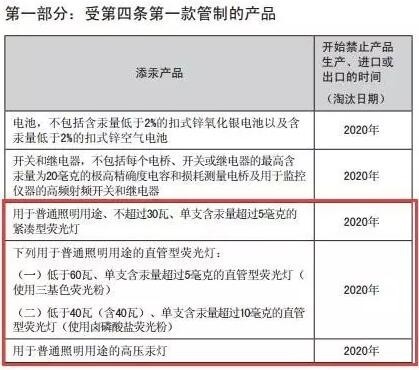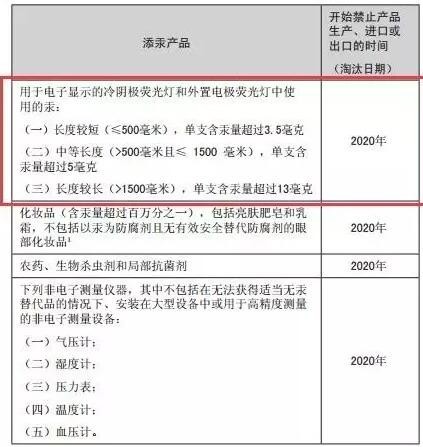Fluorescent lamps will no longer be allowed to use in 2021? Misreading!
2019-09-05 13:54
On the 20th, the media in the industry reprinted the heavy news from the social media. The "Water Mercury Convention on Mercury" will come into effect in August, and "fluorescent lamps will no longer be allowed to use in 2021" immediately became a hot topic. topic.
But is this really the case? As a representative of China's lighting industry, which has been directly involved in the international negotiations on the Minamata Convention on Mercury in the Ministry of Environmental Protection, China Lighting Association immediately discovered the misunderstanding of this news by social media. In order to release rigorous and correct policy information to the industry, the China Association for the Advancement of the Association has been collating the relevant documents of the Minamata Convention for the past five years, and after obtaining the official press release of the July 20 press conference of the Ministry of Environmental Protection. Will be correctly interpreted around the "Water Margin Convention on Mercury":
What is the impact of the Convention on lighting products?
According to the content of the Convention, some fluorescent products are regulated by the Convention and will be subject to the control of Article 4, paragraph 1, of the Convention, namely: “Each Party shall take appropriate measures and shall not be allowed to deal with the first part of Annex A. Such products are produced, imported or exported after the date of the phase-out of the listed mercury-added products, unless an exception has been specified in Annex A or the Party has registered an exemption in accordance with Article 6. Is the legal text, is it a little dizzy? It doesn't matter. Simply put, as a State party, China will no longer allow the production and import and export of products containing mercury exceeding the limit after 2020.
Haven't read it yet? It's ok! Let's focus on the following! These products, which contain mercury in accordance with the following requirements, will still be able to be produced and imported normally after 2020!
For general lighting with power less than or equal to 30w, compact fluorescent lamps with a mercury content of less than 5mg
Three-color toner straight tube fluorescent lamp with a power of less than 60W for general lighting and a mercury content of less than 5mg
For general lighting with a power of 40W or less, a halogen powder straight tube fluorescent lamp with a mercury content of less than 10mg;
At present, China's relevant national standards and industry standards on the mercury content of fluorescent products can fully meet the requirements of the Convention for the mercury content of the above products, therefore, most fluorescent products are exempted, that is, after 2020, Will still be able to produce and import and export.


It should be pointed out that the limited content of the convention for the lighting industry is through the cooperation of the global lighting associations, including the European, American, Japanese and Chinese lighting industry organizations. After more than two years and all The results of multiple negotiations between relevant parties of the United Nations Member States. The final negotiation results are in full compliance with the expectations of the global lighting industry for the future development and development of the lighting industry.
The Global Lighting Association was established in 2007 and includes industry associations in China, the European Union, the United States, Japan, Australia, South Korea and other major lighting electrical products manufacturing and use countries or regions. The China Lighting Association (CALI) is one of the sponsors of the organization and a major member of the Environmental Working Group and the Semiconductor Lighting Working Group under the Global Lighting Association. In this global mercury convention negotiation, the industry organizations of GLA member countries including China Lighting Association have fully played the role of communication and coordination with their governments and production enterprises, and actively promoted the implementation of mercury-containing electric light source products. The consensus reached among the member states has played a positive role in achieving the global mercury reduction target and maintaining the production and trade stability of the global lighting electrical industry. It has successfully assisted the parties to the convention to reach an agreement in the field of mercury-containing electric light source products. Complete the negotiation activities of the Convention.
After the signing of the Convention, China Lighting Association continued to actively cooperate with China's industrial authorities and environmental protection authorities, and jointly carried out the relevant capacity building, technological transformation and market guidance in the lighting industry during the implementation of the future convention. A number of research projects and implementation projects have helped China's lighting electrical appliance manufacturers to upgrade their technology.
China Lighting Association also hopes that all relevant production enterprises in China will actively pay attention to and correctly understand the contents of the Convention, improve production technology in time, effectively reduce the mercury content in fluorescent lamp products, and provide support and guarantee for the lighting industry for China's compliance commitment. At the same time, China Association for the Advancement of the Association also recommended relevant enterprises to accelerate the adjustment of their own product structure and transformation and upgrading, actively respond to future market changes, and work together to promote the sustainable and healthy development of China's lighting industry.
Extended reading:
1. What is the Minamata Convention on Mercury?
The Minamata Convention on Mercury, named after the historically known Japanese Minamata disease, is a new global convention established in the field of environment and health in the past decade, with the goal of protecting human health and the environment from mercury and The hazards of anthropogenic emissions and release of its compounds. The Convention regulates mercury from the full life cycle, covering the supply of mercury, the use of mercury in products and processes, the release of mercury from the atmosphere and its release into soil water, waste and contaminated sites. The 52 future parties include the United States, Japan, the European Union and other countries or organizations, including 12 in Europe (including the European Union), 8 in North America, 5 in South America, 8 in Asia, and 19 in Africa.
On October 10, 2013, China signed the "Watermark Convention on Mercury" at the Diplomatic Plenipotentiary Conference. On April 28, 2016, the Standing Committee of the National People's Congress approved the Convention. On August 31, 2016, China deposited the instrument of ratification of the Convention with the United Nations and became the 30th ratification country of the Convention. At this stage, China is one of the major countries in the use and discharge of mercury, and there is a long way to go to implement the Convention.
Second, why should it take effect in August 2017?
On May 18, 2017, the European Union and its seven member states (Bulgaria, Denmark, Hungary, Malta, the Netherlands, Romania and Sweden) submitted to the United Nations the instrument for ratification of the Minamata Convention on Mercury. So far, the number of future parties to the Convention has reached 52. According to the provisions of the Convention, the Convention will enter into force on the 90th day after the date of deposit of the 50th instrument of ratification, acceptance, approval or accession. Therefore, the Minamata Convention on Mercury will enter into force on August 16, 2017.
3. What did the convention say?
On January 19, 2013, the United Nations adopted the Minamata Convention on Mercury, which aims to effectively prevent mercury emissions and releases in many areas, including electric light sources, in the form of legal instruments worldwide. The contents of the Convention’s instruments cover mercury sources and trade, mercury-added products, production processes using mercury or mercury compounds, exemptions available to Parties upon request, artisanal and small-scale gold mining, emissions, releases, etc. The five contents, which cover the main contents of the lighting industry are as follows:
Based on the positive contribution to climate change, mercury use in the lighting industry should be guaranteed;
Allowing the retention and supply of mercury for use in electric light sources, including mercury pellets;
The performance of the lighting industry is subject to conditions, and the production, import and export of electric light source products within the allowable range are not restricted;
The treatment of mercury-containing waste will be consistent with the current United Nations Basel Convention.
(Source: OFweek Semiconductor Lighting Network)
Related News







